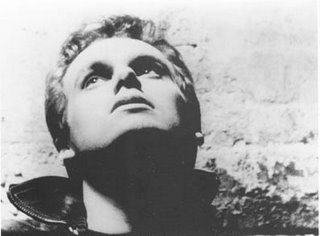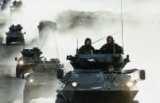Should the state have the right to execute a human being, for crimes of murder, treason, trafficking, mutiny, genocide, or whatever other heinous offence in law? The state's right to deny life was questioned by Milanese writer and academic Cesare Beccaria (1738-1794) in his famous abolitionist treatise, Dei delitti e delle pene (Of crimes and punishments,1764), calling for rational reform in the law. His influence, directly or indirectly, led to the Leopoldine Code of 1786 in the Grand Duchy of Tuscany where, for the first time in Europe (and possibly the world) the death penalty was abolished.
In the map above, countries in blue have no death penalty. It exists in the red zones. Others either make limited use of it, or have not in practice had executions for several years. As of 1977 sixteen countries including Canada had eliminated capital punishment; by the end of 2005 the number had grown to 122 (either completely, or for the most part), while 68 countries retained it. The latter, however, include the most populous countries, so that a majority in the world live under authority that can take life.
In the United States twelve states and the District of Columbia have no death penalty, nor do numerous American territories abroad. Michigan abolished it as far back as 1846.
Canada removed the death penalty from the Criminal Code in 1976, and from the National Defence Act (where it remained for military offences, treason, and mutiny) in 1998.
Amnesty International is on record as opposed to capital punishment, along with a world-wide coalition of abolitionists who try to monitor trials for abuses of human rights.
The European Union mandates no death penalty as condition of membership.
Show trials and gruesome executions in Iraq can only enhance profound unease in that country, and elsewhere in the world. Blood vengeance by the state is not an acceptable solution in the modern world.
30 December 2006
29 December 2006
The Queen, Diana, affairs of state, and plausible fiction

The Queen (UK, 2006)
dir. Stephen Frears
rating: ✶✶✶
Clever writing and skilful montage of news clips create an unlikely, yet reasonably successful film about the tense week in September, 1997 when the body of Diana, Princess of Wales was returned to England for burial. Diana's celebrity pop status won out in the end over protocol, and a reluctant Queen accorded the honour of state funeral to the divorced and disruptive mother of the princes. The look at what was going on behind the scenes at Balmoral and Downing Street is plausible fiction, and an excuse to consider the role of symbolic monarchy and tradition in the modern democratic state, not unsympathetically. Helen Mirren in the leading role is quite brilliant, credible, restrained and ultimately human (as well as a remarkable likeness to the original). Michael Sheen as Prime Minister Tony Blair is also excellent in his portrayal of fresh young energy in public life, with a clear sense of nation, and its swift changing dynamics (another close look-alike). Other roles are less important, occasionally muddled, and sometimes biased. Younger supernumeraries on the scene add contrast as smart-ass irreverent sceptics, and the film suggests a deeper crisis of monarchy than probably in reality occurred. Ultimately, in any case, the nation appears to overcome whatever trauma there was, with institutions and Her Majesty comfortably intact.
06 December 2006
The History Boys

The History Boys (UK, 2006)
dir. Nicholas Hytner
rating: ✶✶✶✶✶
Based on Alan Bennett's excellent 2004 play, and with the original stage cast, the engaging and well-acted film covers the story of a class of eight high-spirited, very bright boys at a grammar school in Sheffield preparing to sit entrance examinations for Oxford and Cambridge. In part a coming-of-age saga, it touches on sexuality both of students and teachers, the education system, English class structure, and the meaning of learning. It succeeds in being both comic and, at times, profoundly moving. A sub-theme on homosexuality further enhances the film's insights into the lives of students and masters alike in the evolving social context of the 1980's.
05 November 2006

Swan Lake
Лебединое озеро
chor. Marius Petipa & Lev Ivanov (1895), Aleksandr Gorsky (1901) / actual premiere 1877
recension: Konstantin Sergeyev (1950)
Mariinsky Ballet
Балетная Труппа Марийнскова Театра
National Arts Centre, Ottawa at the end of October, 2006
Nothing was spared: four acts, several principals, full orchestra with conductor, huge corps de ballet, and tons of gorgeous scenery. At the performance I attended Odette / Odile was interpreted with sensitivity and verve by principal dancer Daria Pavlenko, an exceptionally seductive Black Swan. Unfortunately, at a moment of heightened theatre, her furious 32 fouettés ronds de jambe en tournant en dehors ended in a fall (coda of the Black Swan pas de deux) — the sublime suddenly became human! First soloist Leonid Sarafanov was an elegant, beautiful Prince Siegfried, very much a youth, but strong and precise in movement, with impressive elevation — he commanded full attention. A rare unsteadiness happened with a male dancer, but when the corps was on stage its dancing was marvellously light as well as disciplined. In this version of Swan Lake, in contrast to most, there is a happy fairy-tale ending. The Ottawa audience gave a long standing ovation with cheers.
Lewis Segal, reviewing the present tour, called the company "an imperishable achievement of Russian culture...[Despite] more than 70 years of [Soviet] government meddling, a ruinous imposed aesthetic and the resulting hack choreography, it not only sustained the highest standards but also completely reconfigured and modernized Western classicism. Where it dances, whatever it dances, greatness reigns." [Los Angeles Times, 19 October 2006]
19 September 2006
Afghanistan: mission impossible
I am very upset by the commitment of Canada to an impossible NATO mission in Afghanistan, now projected for five or even ten years into an undetermined future. At the moment the official commitment is only until 2009, but government reiterates that Canada will not cut and run — see: PM Stephen Harper at the UN 21/9/2006, Afghan President Hammid Karzai in Ottawa, 22/9/2006.
Meanwhile as casualties rise, an abundant crop of opium poppies still nourishes the narco-economy, corruption abounds at all levels of state, while Taliban, al Qaeda ("the Base"), unlimited arms and money pass through porous frontiers with impunity.
NATO Supreme Allied Commander General James Jones (U.S.) has called for additional commitments of troops, helicopters, and transport planes for battle in the dangerous Kandahar region where Canadian forces are deployed. Canada, with 2200 troops in the country, has now pledged to increase effectives to 2500.
Afghanistan is now the source of 92% of illegal opium in the world. UN Office on Drugs and Crime 2 September 2006, reported in NYT 20 September 2006
NATO Supreme Allied Commander General James Jones (U.S.) has called for additional commitments of troops, helicopters, and transport planes for battle in the dangerous Kandahar region where Canadian forces are deployed (with British and Dutch). Canada, with 2200 troops in the country, has now pledged to increase effectives to 2500.
A Provincial Reconstruction Team (PRT) of 250 Canadian soldiers is working to restore the authority of the central government in Kabul, as well assisting the rebuilding of essential infrastructure. Taliban and their supporters melt away, blending into the local population in the aftermath of combat — they are virtually undetectable without help.
Chief of Defence Staff General Rick Hillier arrived in Afghanistan on 28 September 2006 to inspect the southern sector in the aftermath of Operation Medusa vs Taliban insurgency.
CTV's Paul Workman, reporting from Kandahar, said Hillier addressed the daily challenges faced by Canadian troops. "He spoke of the difficulties in fighting the Taliban, an enemy that can blend into the villages, uses guerrilla tactics, suicide bombs and bombs buried on the side of the roads," Workman told CTV Newsnet.
"He said it's very difficult for Canadians to deal with that and you just can't go into the villages and start shooting indiscriminately."
ctv.ca news 29/9/2006
The cost to Canada of Afghanistan so far has been $2.3 billion (Sept. 2001-May 2006). Ongoing military expenditure there, in men and equipment, is enormous, a considerable drain on available resources. Another $1 billion in development aid has been pledged over the next 10 years.
ctv.ca news 22/9/2006
Public opinion of the mission expressed in numerous polls has been increasingly unfavourable. Decima Research found that 59% of respondents agreed that Canadian soldiers "are dying for a cause we cannot win", while just 34% disagreed. Results were generally similar across the country.
[current poll taken 8-18 September 2006; Toronto Star from CP, 2/10/2006]
Several deaths have been caused by so-called "friendly fire".
How well are these forces presently equipped and supported for the difficult terrain and conditions of guerrilla warfare?
A UN report has suggested links between Iraqi and Afghan guerillas. New types of bombs that are used in Iraq show up soon later in Afghanistan.
NYT, 8/10/2006
Toronto Star reporting from Kandahar:
"Two Canadian soldiers died yesterday and two were wounded in an ambush of rocket-propelled grenades and gunfire as they guarded a road that has become a prime target for insurgent attacks. ... The Canadians were attacked while patrolling an unfinished four-kilometre road to link the Panjwaii district about 20 kilometres west of Kandahar with a main highway. Soldiers in the region say there just aren't enough of them properly to clear the area of insurgents who've stepped up attacks since a major three-week offensive against the Taliban last month was declared a success by NATO. Six Canadians have died along the unfinished road or the 16-square-kilometre area around it since late September."
[TS, from CP, Reuters, 15/10/2006]
11 September 2006
Andy Warhol: Stars, Deaths and Disasters 1962 - 1964

Supernova, now at the Art Gallery of Ontario (until 22 October), is an assembly of more than twenty silkscreen images and paintings from the sixties, produced by Andy Warhol at his Factory in New York City. This is not the familiar pop-art Warhol of Campbell's soup and Brillo boxes fame. Rather it is of an artist obsessed with celebrity, glamour, sexuality, disaster, catastrophe, and inexorably death. Juxtaposed with Troy Donahue, Elizabeth Taylor, Elvis Presley, and Jacqueline Kennedy are scenes of horrific actual car crashes, poisonings, and suicides, along with frequent stark imagery of the electric chair.
Essential part of the presentation is spoken commentary by David Cronenberg, and by many others — critics, actors, some of whom knew the artist and worked with him. Placed in context the multiple iconographic work and films make a surprising and disturbing impact. When John Giorno (poet) asked the artist: "What are you working on now?" — the answer was: "Death".
Projected on the walls of each room is a film, each a curiosity in its own right, including Empire (an eight-hour static, almost eery viewing of the Empire State Building), Couch (candid everyday sexuality at the Factory), and Blow Job (the sublime face of fellatio), all created in 1964.
PBS recently broadcast a four-hour study of the artist's genius:
Andy Warhol: a documentary film (USA, 2006)
dir. Ric Burns
see: "A portrait of an artist both loved and hated" (NYT, 20 September 2006)
photo: anonymous, in Blow Job (USA, 1964)
Subscribe to:
Comments (Atom)



